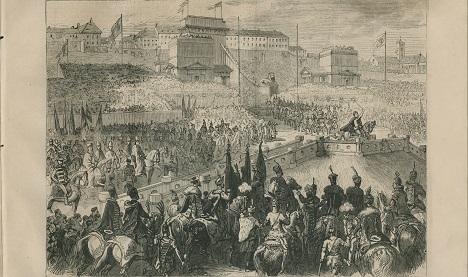
The Andrew and Veronica Jagerski Story:
Slovak Immigrants to Beaver County, Pennsylvania
 |
Coronation of Francis Joseph of Austria as King of Hungary (as Slovakia was then known) -- who was still on the throne when the Jagerskis named their eldest son for him in 1908 --Harper's Weekly, July 27, 1867 |
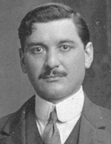 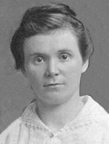 |
Andrew and Veronica, 1913 |
This page is lovingly dedicated to the memory of great-grandparents I never knew. Without their vision, strength and hard work, and ability to withstand hardships and suffering, their scores of 50-plus descendants -- children, grandchildren, great-grandchildren and now great-great grandchildren -- would not have enjoyed a life of freedom and opportunity in the United States.
Andrew Jagerski was born "Andras Jagierski" in Detva on 23 March 1883, then part of the Austro-Hungarian empire, sometimes known as Austria or Hungary (but today northeast Slovakia). Andrew is said to have been one of three children of Anna Jagierski. The father's exact identity is lost to history, although it's rumored that his name was "Novosel." As a young man, Andrew migrated to the village of Saros Megye, in the Bardejov District of the Prešov region. There, he found work as a laborer in a glass factory.
He boarded with a local family who spoke the same Slovak dialect. He stood 5-feet, 8-inches high, with brown eyes and black hair, and a mole on his right cheek. He was noted as a sharp dresser.
Andrew's signature |
At some point, Andrew met an attractive young teenager, Veronica Nachmann. She was born on 7 May 1891 in the nearby village of Richvald, the daughter of Joseph and Paula (Straka) Nachmann. She kept a clean house and had a beautiful flower garden. They fell in love and decided to get married, despite the fact that Veronica was eight years younger. They waited until she turned 16, and were wed on 16 June 1907. The ceremony took place in Saros Megye, and their best man was Jacob Berger. (Berger had a family connection with Art Pallan, a longtime radio broadcaster on KDKA-AM in Pittsburgh.)
The first three Jagerski sons were born in Saros Megye. They were Franz Josef ("Frank Joseph"), born on his father's birthday on 23 March 1908; Julius (1910); and Rajmund Josef ("Raymond Joseph") (1912). Sadly, although Julius was baptized at the Mocroluv Catholic Church, he died of tuberculosis at age two, said to have been contracted from an aunt who was caring for him.
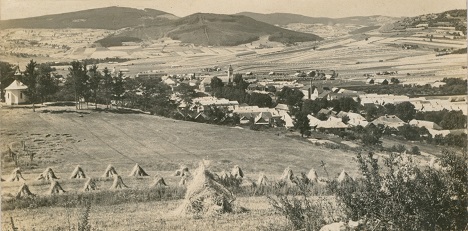 |
Above: Andrew's birthplace, the town of Detva. Below: Bird's eye view of Mariental -- the arrow points to company housing where the Jagerskis lived in the early 1910s |
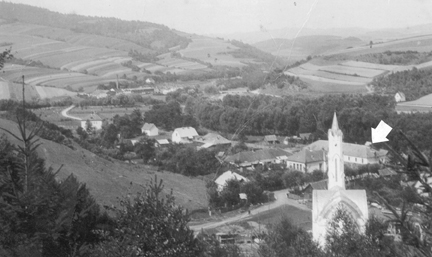 |
The Jagerskis' grandson Donald Jagerski, who extensively researched the family in the early 1980s, reports that "The towns of Mariental, Siba, Krizov, Richvald, Livo-huta, and Kruzlovska-huta are located very close together in the Eastern region of Slovakia, near the large town of Bardejov. Depending who was in government control at the various times, the names translated are in the Slovak, Hungarian or Czechoslovak language."
Andrew was considered an expert glass cutter. His son Frank, as a 4- or 5-year old, often brought water to him at work. Once, while carrying a filled bucket, the boy fell and cut his chin, and carried a knobby scar for the rest of his life. Young Frank also raised rabbits, and a neighbor boy pestered him for one. Frank repeatedly refused. One day, one of the rabbits was crushed to death in an accident. Frank gave the mangled remains to the friend, saying, "Here's your rabbit."
In 1912, and perhaps earlier, Andrew and Veronica made the monumental decision to leave their home and migrate to America, despite mixed feelings in the family. Veronica's father, also an expert glass cutter, had lived and worked briefly in Toronto, Ohio circa 1908, before returning home for good. He said that the only thing he liked about America was the beautiful Ohio River. Veronica's Uncle Wenzel Straka also lived Toronto, and remained permanently, and played a key role in bringing the Jagerskis to America. The irony is that Uncle Wenzel and his wife Theressa and their three eldest children had emigrated to the United States in 1888, before Veronica was born, and thus she did not know them, other than by reputation, until meeting upon her own arrival in 1913.
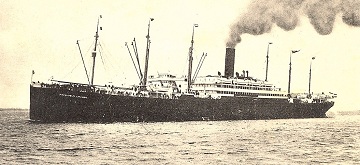 |
The S.S. President Lincoln, which brought Andrew and Veronica to America on separate voyages. Below, the Hamburg American Line piers in Hoboken, NJ. |
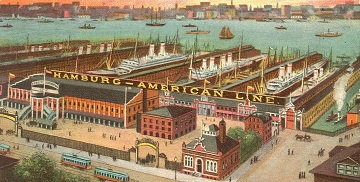 |
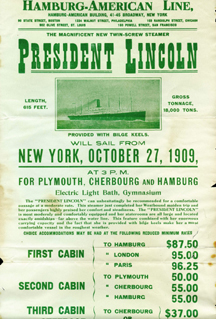 |
Broadside from 1909 advertising passage on the Lincoln, sailing from New York to Germany. |
The Jagerskis' plan was that Andrew would emigrate first, and establish employment and a home, and that Veronica would follow with their two young sons. The decision to emigrate is not difficult to understand. The Austria-Hungary that the Jagerskis left behind was on the brink of political and military turmoil, as its neighbors Bosnia and Herzogovina were at war, posing a threat for major spillover conflict. It was not a fitting place to raise a family with any hope for the future. Indeed, just one year after Veronica left, a political assassination plunged the country and all of Europe into World War I, leading to an unfathomable 37 million dead. Ironically, the Jagerskis' old and new countries became wartime enemies, with Austria-Hungary siding with Germany in the fight against the United States.
To enter the U.S., Andrew needed an American resident as a sponsor, and Uncle Wenzel Straka in Ohio agreed to serve in this role, even though he did not know the young couple other than through correspondence and possibly photographs. And so it was that Andrew left his wife and sons, and made his way to the German port city of Hamburg. There, he boarded the steam ship President Lincoln, one of the fleet of the Hamburg-American Line (in German, the "Hamburg-Amerika Linie").
The Lincoln had only been in operation for five years at the time it carried Andrew to New York. It was 619 feet long and 68 feet in its beam width and weighed 32,500 tons.
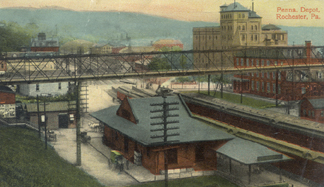 |
Pennsylvania Railroad station in Rochester circa
1912, about when Andrew would have
arrived |
Andrew sailed for New York on 18 Sept., 1912. After 12 days on the ocean, the Lincoln docked at Ellis Island on 30 Sept., 1912. Thus Andrew became the first known relative with the Jagerski name to set foot on American soil -- with all of $14 to his name.
Andrew's first stop was Toronto, Ohio, where Uncle Wendell Straka was living. Within a few months, in December 1912, he moved to the Ohio River town of East Rochester, Beaver County, PA, where he established a home.
At around that time, he must have sent word to Veronica to begin preparing for her own voyage.
Andrew must have regarded Rochester and the Beaver Valley as an attractive region due to widespread industry and available employment. The river valley was booming with active steel mills, manufacturing works and railroads. One wonders what he fear or fascination he may have felt a few months after his arrival, in the spring of 1913, when the mighty Ohio River rose to flood levels and engulfed the lower parts of town.
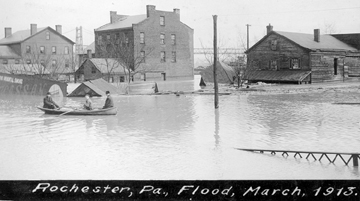 |
| Rochester floodwaters of March 1913, Andrew's first spring in the U.S. That month, he reached age 30, and his son Frank turned 5, separated by thousands of miles. |
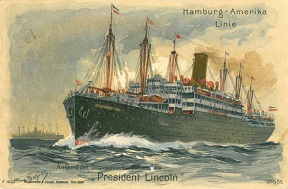 |
The President Lincoln |
During her husband's absence, Veronica is believed to have lived with her parents in Mariavolgy. When the time came for her to depart with her sons, leaving behind her extended family and the grave of her infant son Julius, it must have been a very emotional time. As a testament to his confidence in Veronica's decision to emigrate, her father paid for her ship ticket.
Because the threat of war was looming ever-nearer, Veronica and the boys were not allowed to openly cross the Austro-Hungarian border. Thus, she opted to depart during the dark of night through the veil of a forest.
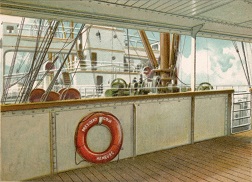 |
View from the Lincoln's deck |
It would not have been easy to carry baggage along with a 5-year old boy and a 10-month-old toddler. Veronica's mother or sister is said to have helped through that first, dangerous leg of the voyage, walking and running over the hills, likely terrified. While en route, one of the boys, likely Raymond, began to cry. He had to be quieted so no one would hear them fleeing.
Ultimately, Veronica, Frank and Raymond followed the same route as Andrew, and went to Hamburg, Germany. On 24 May, 1913, they boarded the President Lincoln, the same ship that had carried Andrew eight months before.
While on the Lincoln's deck in port, Frank dropped his cap, and as it fell into the ocean far below, never to be seen again, he burst into tears, something he remembered for the rest of his life. With $40 in her pocket, Veronica and her sons were at sea for 13 days, and landed at Ellis Island on 6 June, 1913.
(Another irony -- the ship later was seized by the U.S. Government in World War I and during five voyages transported 23,000 American troops to France. On its return to New York, it was torpedoed and sunk by a German U-boat on May 31, 1918, about 600 miles from the French coast.)
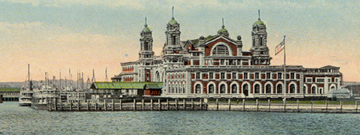 |
Ellis
Island, New York -- where Veronica and sons first set foot on U.S. soil,
some eight months after her husband. Below, queue line of immigrants waiting to be processed. |
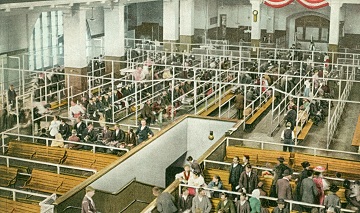 |
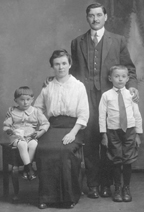 |
Andrew, Veronica and
boys upon their reunion
in America |
How Veronica and sons traveled from New York to East Rochester is unknown, but likely it was via the Pennsylvania Railroad. It is doubtful she knew much English. Completing this stage of her voyage must have been very frightening.
After arriving, Veronica and the boys moved into the house Andrew was renting at 420 Rochester Avenue in East Rochester. They also had a family photograph portrait taken together, likely to send to relatives back in the "Old Country."
When world war exploded in Europe a year later, on 1 Aug., 1914, one can only imagine the emotions Andrew and Veronica would have felt for the safety of their loved ones far, far away. Veronica must have felt a measure of comfort and reassurance that her uncle and aunt lived just 38 miles downriver along the mighty Ohio River.
The Jagerski family lived in several places in East Rochester over the years. They boarded with the Plockovich family at 833 Spruce. They then moved to a farmhouse on Maple Street, which has since been torn down. In 1920, they made a monumental decision to purchase a two-story frame house at 814 First Street to accommodate their growing family. This house, on a lot 50 feet by 150 feet, became the family's permanent residence for almost a quarter of a century, until the mid 1940s.
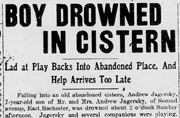 |
Andy Jr.'s obit, Beaver Valley Times |
While in East Rochester, Veronica gave birth to seven more children -- Andrew (1916), Anthony John (1917), Rudolph Michael (1919), Margaret Joan (1922), Irene (1924), Carl Joseph (1928) and Theresa Marie (1930). All told, she had 10 children, but was never quite the same after the birth of her last baby. Sadly, she would outlive three of her offspring.
In mid-May 1923, the family would have received word that Veronica's married cousin, Pauline "Lena" (Straka) Perun, had died of pneumonia at age 26 in Toronto, Ohio.
Tragedy again struck the family with a devastating blow later that year, on 11 Nov., 1923. Son Andy, while running after some friends, fell into an abandoned cistern and drowned. The Beaver Valley Daily Times reported that:
"The boy and several companions
were playing and it is said Jagersky backed into the cistern, which is located
on Walnut street, and about two blocks from his home. The cistern belonged
to some houses that were razed some time ago, it is said, was uncovered and
full of water. Before assistance could be summoned and an effort made to save
him, the boy was drowned. The body was recovered about a half hour later and
taken to the home of his parents." |
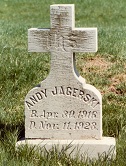 |
Andy's grave at St.
Cecelia Cemetery |
The Times said that "Funeral services with high mass of requiem were held in St. Cecelia's Church... There were many beautiful floral tributes from relatives and friends." He was buried at St. Cecelia Cemetery, and a stone was placed on his grave. (This marker was replaced by a standard, flat stone circa 2007, with no reason given.)
Heartache rocked Veronica again in 1925, when her uncle Wenzel's wife Theresa died of heart disease, removing a key link from the family.
Just one year later, the shadow of death again visited the Jagerskis. Toddler daughter Irene caught a combination of the flu and pneumonia, and she died on 30 March, 1926. She had not yet reached her second birthday. Irene was laid to rest in the infants' section of St. Cecelia Cemetery, along one of the edges of the property, but her grave was never marked. For many years the family knew the location of Irene's grave because it was beside a large tree stump. Today, however, that stump is gone, and knowledge of the exact spot is lost. Records of the cemetery were destroyed in a fire, and despite periodic inquiries by family members over time, her precise gravesite will never be known.
Just a few days before Christmas 1928, the grim reaper again took its toll when Veronica's cousins Wenzel Robert Straka, a laundry worker and said to have been the "father of baseball in Toronto," died of myocarditis and pneumonia. And four years later, her Uncle Wenzel passed away of chronic heart disease and hardening of the arteries at the age of 73 on 18 Feb., 1932.
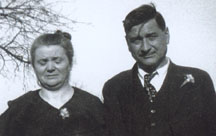 |
Veronica and a well-lubricated Andrew at a son's wedding in 1933. |
In November 1933, during the Great Depression, Andrew went to the county court house and filed papers to become naturalized as a U.S. citizen. In his petition, he renounced any loyalty to the Czechoslovak Republic. The application took six years to process. At long last, on Feb. 21, 1939, he was sworn in as a citizen, taking the Oath of Allegiance. He must have been filled with great pride to be an official American at last.His typewritten petition and photo are on file today at the Beaver County Courthouse in Beaver, PA. Sons Frank and Raymond also became citizens in the late '30s.
In November 1933, the same month as Andrew declared his intention to become a citizen, the first of his and Veronica's children was married -- eldest son Frank, who wed Helen Balysh of near New Brighton, Beaver County. The ceremony was held at the Holy Ghost Russian Orthodox Church in Ambridge, and the wedding reception was held at the bride's home. Despite the fierce grip of the Depression, food, drink and music were plentiful during the three days of festive celebration.
A snapshot photograph of Andrew and Veronica was taken in the driveway of the Balysh farm home, on the day of Frank and Helen's wedding. Andrew, who had enjoyed a few libations, loosened his necktie for the image.
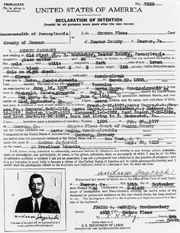 |
Andrew Sr.'s naturalization paper on file in Beaver, PA |
Their other five children were married over the years: Raymond to Catherine Kovach in Columbus, Ohio; Anthony to Marcella Breeher in St. Louis; Margaret to Joseph P. Nevin Sr. in 1953 in Alaska; Carl to Betty Jane Coleman in 1954 in Monaca, PA; and Theresa to Walter Glowacz in 1965 in Gardena, CA. Only their son Rudolph, a World War II veteran of the Marines, never married but spent his adult years bartending in Reno, NV.
Andrew is said to have been a "staunch Democrat" in his political leanings. He tried to find jobs in his specialty craft of glass cutting, and for a time labored at Beaver Valley Glass on Water Street in East Rochester. Their home contained many fine examples of his work, but these were given away as gifts to family and friends over the years, and on occasion were accidentally broken. None of his pieces are known to have survived to today.
When he had spare time, Andrew loved to listen to the Amos 'n Andy popular comedy radio show, featuring the misadventures of two southern characters who had landed in New York. The humor gave him a reason to laugh. At some point in time, when a next-door neighbor installed electricity in his house, Andrew made arrangements to tap the wiring and share the energy source and related cost. The Jagerskis put the electricity into use for one light bulb which dangled from the ceiling of their dining room, and to power the radio. After a few months, the neighbor complained that the family was using more than its share. "Pup got mad and tore it out," recalled a son.
When the Great Depression struck with crippling force, Andrew was unemployed for two or three years. He took on odd jobs, including cooking for "Johnny Bell's Camp" farm in Raccoon Township; building split log benches; digging graves at St. Cecelia Cemetery; and working as a watchman at a mill on Water Street. He also is believed to have secretly brewed beer for the local Owls Club and maintained a still in the woods behind his home, making whiskey which he sold for $8 a gallon. (Only he and son Frank knew the still's hidden location.) Andrew worked at his last job, at the Colonial Steel Mill in Monaca, until June 1939.
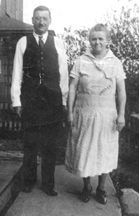 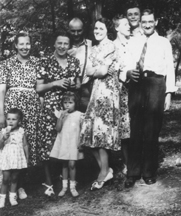 |
Images from the 1930s: Veronica and Andrew at their home, summer 1935. Right,
Andrew (far right) next to Frank and Helen, granddaughter Connie and
friends. |
The Jagerskis' first grandchild was born in 1934. From his front porch in East Rochester, Andrew was able to look across the Ohio River and see the little girl playing in her parents' yard in Monaca. He enjoyed giving her lollipops.
During the 1930s, Veronica began to suffer from emotional or mental anxiety or illness. It became apparent to the family as they saw their mother's condition decline. With two of her children away in the U.S. Armed Forces during World War II, her anxiety only worsened.
Sporadically, the Jagerskis and their son Frank exchanged letters with beloved relatives back in Slovakia. In about 1937, son Frank wrote to his Grandfather Josef Nachman whom he had not seen for nearly a quarter-century, and whom he would have remembered only as a wisp of a memory. In the letter, Frank acknowledged a gift of medicinal pills that they had sent for his mother. In turn, both Frank's grandfather and grandmother Nachmann both sent replies in Slovak which still survive today and are moving in their language. Josef's reply said (translated here):
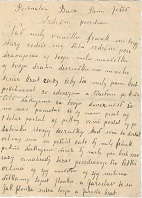 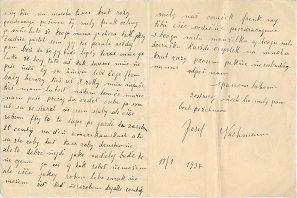 |
Above/below: Josef Nachman's letter to grandson Frank Jagerski. |
Glory be Lord Jesus
Heartfelt Greetings
Our dear grandson Frank, we, your old grandparents send heartfelt wishes to your beloved wife and darling daughter many thousand times over, that the dear Lord will bless you with health and happiness. We thank you for your kidness that you remembered us by writing and sending a dollar and lovely greetings. Also for the picture of your daughter. I was very delighted when I received it. For that my dear Frank, thanks very much. May the dear Lord repay a 1,000 times over. Your aunt sends best regards with her husband and hear dear children, Jlonka [Anna] and Jaroslav [Jerry]. That is, Jlonka your sister [cousin] and Jarosla, brother [cousin]. They send many thousands of good wishes too. I write you dear Frank that I’m sorry your Mama is so ill. I sent her those pills hoping the good Lord makes her better. I’m sorry that your father has not written to me for such a long time. Is he angry or what? Henry, also has not written for three years. Only Marie writes to let us know about herself. I've gotten old and am weak but still work in this shop, in the yard to earn 25 cents a day in American money. Work is bad. Here the shop isn't working too well. How it will be in the future I don't know. I'll not be able to work much longer, but can't live unless I earn a few cents. Our dear grandson Frank, we again send greetings to your beloved wife and dear daughter. All of us together, many times over. I ask you to please don’t forget to write to us. May the good Lord bless you. Josef Nachman 18/1 1937 |
Grandmother Paula (Straka) Nachman's letter, probably inserted into the same envelope as Josef's, read as follows:
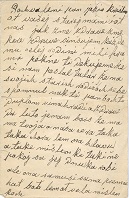 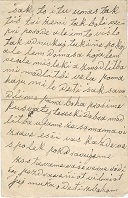 |
Above/below: Paula (Straka) Nachman's letter circa 1937. |
Greetings in the name of Jesus Christ from your Grandmother. We are well, and wish you and your family good health, dear Frank. We thank you for thinking of your grandparents and for the dollar you sent. May the Lord repay you doubly. We are sorry that your Mother, and our daughter, is so ill with such thoughts and confusion in her head. She has to try to overcome it herself. Here too, three women were that way, but they recovered. Good thoughts and prayers will help much. Dear children we pray to the good Lord and ask St. Teresa in hopes that your mother will regain her health. Once more we send to all of you our best wishes for good health. We remain your faithful relatives, with the Lord. |
He spent the final six months or year of his life bedfast, with his bed brought to the first floor living room since he could no longer climb stairs. He frequently spit blood into an empty tin can. As he was dying, in September 1939, he received the devastating news that his old homeland again was at war. Adolf Hitler's Nazi German Army had invaded what was now Czechoslovakia, in a blitzkrieg prelude to World War II.
|
Colonial Steel Works in Monaca, where Andrew last worked in 1939. |
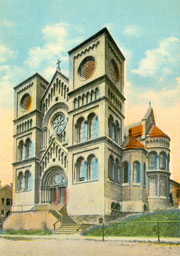 |
St. Cecelia Roman Catholic Church in Rochester |
On 24 Jan., 1940, knowing the end of his life was near, Andrew scribbled a short, two-sentence will: "I do hereby will everything I own, my property and all my possessions to my wife Veronica Jagerski. My house and lot situated at 814 First St. East Rochester, Pa." At the end, he had to sit up in bed, and his breathing became terribly labored.
Sadly, he died just three days after writing his will, just after midnight on 27 Jan., 1940. Son Carl, age 11, and daughter Theresa, age eight, stayed up with him at the end, late into the night. At some point Carl was semt upstairs to where Theresa was saying prayers. After Andrew passed, Veronica slowly walked up the stairs and said simply and matter of factly, "Carl, Papa died."
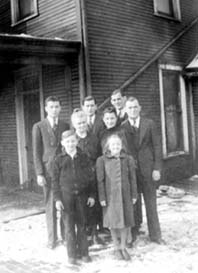 |
Andrew Sr.'s funeral, clockwise
from lower left: Carl,
Rudy, Tony, Raymond, Frank, Theresa. Center, Veronica and Margaret. |
With a kindly neighbor driving, Carl was sent on an errand in the dead of night, across the Ohio River to Monaca to deliver the news to his brother Frank. Telegrams were wired to family around the country, including to son Raymond in Columbus, Ohio; son Tony in St. Louis, Mo.; and daughter Margaret in Huntington, W.Va., as well as uncles and aunts in Ohio and West Virginia.
Andrew's viewing was held in the Murphy Funeral Home in Rochester, followed by his funeral at St. Cecelia and interment of his tired remains were laid to rest at St. Cecelia Cemetery. He had been in the United States for more than a quarter of a century but an American citizen for only less than a year.
During her marriage, and especially as a widow, Veronica missed her family in Europe very much. Fortunately, her sister Maria and brother Henry had come to the U.S. in about 1920 on the ship Mauritania. Maria married Earl Boyer and settled in Huntington, WW, and Henry lived in Columbus, OH.
Veronica worried during World War II when son Rudy and daughter Margie served in the U.S. Armed Forces overseas. (Today, the names of Rudy and Margie are permanently inscribed on large plaques on the war memorial in Rochester.)
In 1944, Veronica sold the family home, and moved with her youngest children Carl and Theresa to a small house on Elm Street, across the river in Monaca Heights. At the end of World War II, when the Soviet Union took possession of Czechoslovakia, the name of the Jagerskis' former town Mariental was changed to Livovská Huta, also known as "Livo" Huta.
For the last two years of her life, Veronica suffered from hardening of the arteries. Then on 22 Aug., 1957, she suffered a cerebral hemorrhage. She was treated by Dr. Melvern M. Mackall of nearby Beaver, but her health ebbed away. She passed away at home at the age of 66 on 29 Aug., 1957. She was buried in St. Cecelia Cemetery, with a small stone to mark her final resting place. Her burial site is directly across the internal cemetery road from her husband, who rests upon a small hill.
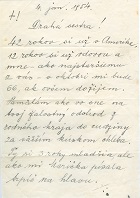 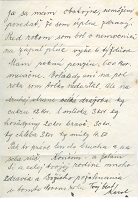 |
Karol Hervatovsky's letter to his sister Veronica, 4 Jan., 1954 |
Dear Sister! 42 years already you are in America. 12 years already you are widowed and I, the eldest of you, will be 66 in October if indeed I live till then.I remember as in a dream your sad departure from your native land to a foreign one for your piece of bread.You are 3 years younger but Mary wrote me that you suffer with your head. I am tolerable, can’t say that I’m perfectly healthy. Last year I was in the hospital with pneumonia for over 6 weeks. I’ve a nice pension, 600 kor. monthly. At one time I didn’t get that much for half a year. But on the other hand prices are very high. Kg. sugar, 12 kor, lb milk 3 kor, kg beef 20 kor, pork 30 kor, kg bread 3 kor, kg flour 4.50. So it’s all for the belly and none for myself. In closing I wish you and all your family much health and God’s blessings in the New Year. Your brother,
|
 |
Veronica, mid-1940s |
The Jagerski descendants have lived in many parts of America -- Washington, D.C., Pittsburgh, Boston, Chicago, Los Angeles and St. Louis, as well as London, England. They have sought their own way in the fields of architecture, healthcare, engineering, aviation and public relations ... in teaching, manufacturing, Internet services and the military ... all making their mark on American life and culture in unique ways.
None of this would have been possible without a brave decision by a young Slovak couple in 1912 -- sponsored by an uncle they had never met -- to seek a new life with their two eldest sons in the United States.
Andrew's grave was never marked with anything more than a small metal plaque. Over time, the metal disintegrated, and the precise location of the grave faded from memory. However, in 2003, his surviving sons Carl and Rudolph and daughter Margie took the initiative to have a marker placed in the vicinity, with assistance from Rome Monument Company. The stone was installed in August 2003, so that Andrew's memory would be preserved in stone forever.
Also in August 2003, Veronica's nearby marker was professionally washed and cleaned, removing some dark staining around the lettering.
The efforts of Andrew and Veronica's grandson Donald Jagerski in the 1980s to do extensive research, including many inquiries to Czechoslovakia, and then his efforts to type his notes, have all been extremely helpful. This web-biography is built in part on the foundation of his great work.
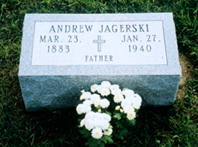 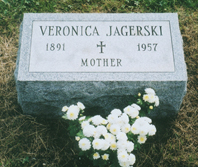 |
Jagerski grave markers at St. Cecelia Cemetery |
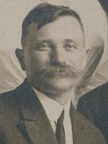 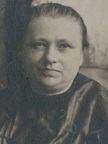 |
Wenzel Sr. and Theresa |
About Uncle Wenzel C. Straka
Veronica Jagerski's uncle Wenzel C. Straka (1858-1932) was the man most directly responsible for sponsoring the Jagerskis to emigrate, and thus, directly, for all of our lives here in America.
Wenzel was born on 20 Oct., 1858, the son of Wenzel Straka, a native of Austria-Hungary, and an unknown mother, of Bohemia.
He married Theresa "Trecie" Rankel (1860-1925), daughter of Michael and Josephine (Blasko) Rankel. The date and place of their nuptials is not yet known.
They went on to produce 10 known children, among them Mary Palchak, Rosa Tulencik, Wenzel Robert Straka, Thomas M. Straka, Anna Straka, Amelia "Millie" Straka, Pauline Cecelia "Lena" Perun, Irene Conroy, Margaret Mary Conlon and Albert A. Straka.
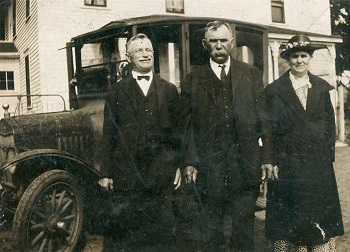 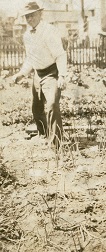 |
Wenzel (left) with brother-in-law Tom Rankel and wife; and in his garden at 712 North Fourth Street in Toronto |
The couple and their three eldest offspring emigrated to the United States in 1888, when Wenzel was age 30, and Theresa 28. They first resided in the Braddock section of Pittsburgh, where steel mills were hiring immigrant workers.
In about 1893, they migrated to the Ohio River town of Toronto, a suburb of Steubenville, Jefferson County, Ohio. Their eldest daughter Mary may have stayed behind, as five years later she married a Braddock man, and they established their home and family in that community.
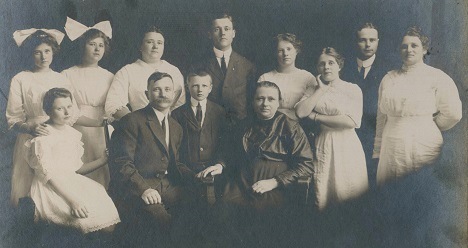 |
Strakas circa 1910 -- Front, L-R: Margaret, Wenzel Sr., Albert, Theresa, Amelia, Rose. Back, L-R: Lena, Irene, Mary, Wenzel Jr., Annie, Thomas. |
|
St. Joseph's Church, Toronto |
In Toronto, the Strakas' home was at 715 North Fourth Street. Wenzel owned and operated a grocery business in the north end of Toronto, and was assisted at times by his sons. They were members of St. Joseph's Roman Catholic Church of Toronto, and for 34 years Wenzel served as president of the local Slovak lodge.
The family has not yet been found on the 1900 and 1910 federal census enumerations. Also living in Toronto circa 1900 was the "Hungarian" family of John and Mary Straka and their children Mike, Anna, John, George and Kate.
In April 1912, when Wenzel and son Thomas went to Steubenville on business, the news was reported in the gossip columns of the East Liverpool Evening Review, and due to the editors' unfamiliarity with Slovak names, published the father's as "Straka Wenzel."
The Strakas' church was located at the corner of Fourth Street and River Avenue, and had about 1,000 members in the late 1920s. A description of the church was published in the 1929 booklet, Industrial History of Toronto:
| The immigration of Slovaks to Toronto began about the year 1880 and their numbers increased to such an extent that they felt able to establish a church of their own. The Slovaks of those days were poor, indeed, in the world's goods, but rich in the heritage of the faith of their fathers. They were a hard working, thrifty, honest and deeply religious people. |
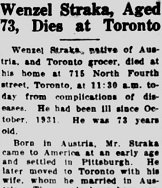 |
Steubenville Herald Star |
The family grieved when on 16 May, 1923, their daughter Lena Perun passed awayat the age of 26, of pneumonia, just two months after giving birth to her only child.
Theresa died of heart disease and pneumonia the day after Christmas 1925, at the age of 65. An obituary in the East Liverpool Review-Tribune noted that "She leaves her husband and several children." Funeral services were held in the St. Francis Catholic Church, although why not in the family church of St. Joseph's is not yet known..
Wenzel outlived his bride by seven years.
Heartbreak enveloped him and the family just four days before Christmas 1928, when son Wenzel Robert Straka -- a popular local athlete widely considered the "father of baseball in Toronto," but suffering from heart disease and pneumonia, succumbed at the age of 41.
Wenzel himself suffered from chronic heart disease and hardening of the arteries. He died of their effects at the age of 73 on 18 Feb., 1932. He was laid to rest beside Theresa in the Straka family plot of graves in Toronto's Union Cemetery.
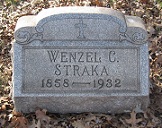 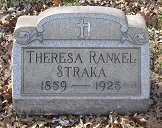 |
Union Cemetery, Toronto, Ohio |
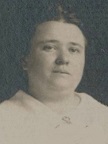 |
Mary Palchak |
Cousin Maria "Mary" (Straka) Palchak
Maria T. "Mary" Straka (1883-1955) was born on or about 18 Oct. 1881 or 18 Nov. 1883 in the old country. She came to America with her parents when she was five years of age.
At the age of 16, on 25 April 1898, Mary married 26-year-old wire worker Stephen Paul Palchak (19 April 1871-1935), also spelled "Istvan Palchak." Rev. A. Kazincz performed the nuptials.
Stephen too was born in Eastern Europe, in the town of Kemecse, Szabolcs, Hungary, the son of Janos "John" and Zsuszanna "Susanna" (Uncza) Palcsak. At the age of 17, in 1889, he had sailed to America by himself on the SS Saub. He became a naturalized citizen in 1896.
The couple produced 10 children -- among them Mary Paris, John Palchak, Anna Palchak, Stephen Paul "Steve" Palchak Jr., Margaret Palchak, Peter Palchak, Madeline Palchak, Irene Victoria Stypulkowski Zilko, Albert G. Palchak, Bernard Palchak and Louise Herbert. [These names all need to be confirmed.]
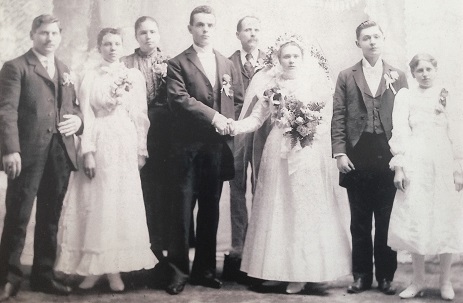 |
Mary and Stephen Palchak's wedding, 1898 |
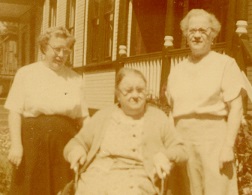 |
Mary (seated) and sisters Millie and Annie at her home in Braddock |
Stephen apparently had a desire to be self-employed and to seize on the economic opportunity in the shadows of the famed steel mills of the United States Steel Company, along the Monongahela River in Braddock south of Pittsburgh. In 1900 he applied for a liquor license in Braddock, but it was rejected (among many other local applicants), with his name printed in the Pittsburgh Daily Post. Again in April 1902, now living at 1224 Halket Avenue in Braddock, his application to operate a saloon was refused. He eventually acquired three town lots on Ninth Street in Braddock for which he paid $12,998 in 1911. Then in 1912, he purchased another lot in Braddock measuring 25 feet by 150 feet, from Daniel Askin, paying $5,600. He added to his real estate holdings in May 1913 with a 35 feet by 150 feet lot on Ninth Street ($10,500).
Stephen eventually found a way to operate a saloon. But in January 1920, the 18th Amendment was passed into law, known as the Volstead Act which established Prohibition making it illegal to produce, sell or transport intoxicating liquors. That same year, Stephen was cited for selling whiskey in his establishment in July and October 1920 and pleaded no defense when brought to trial in the United States District Court. Again the following year, he was among 19 Braddock residents indicted before a federal grand jury for violation of the Volstead Act. He faced legal action in 1925 on charges of "illegal liquor selling," reported the Pittsburgh Press, but was acquitted.
The federal census enumeration of 1920 shows the family making its residence on Brenham Street, with Stephen working as laborer in a pipe mill, and daughters Mary and Anna as a machine runner and packer, respectively, in a biscuit manufacturing plant.
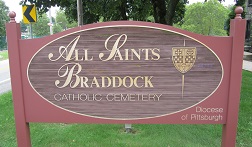 |
All Saints Cemetery, Braddock |
Circa 1930, they Palchaks lived on Gallam Street in Braddock, with Stephen now employed as a laborer at a university, and son Peter as a burner in a copper mill. Their address circa 1935 was 107 Ninth Street in Braddock.
Suffering from a heart lesion and vascular renal disease, Stephen retired and, six months later at age 64, passed away on 21 Feb, 1935. Burial was in All Saints Braddock Catholic Cemetery. John A. Palchak, of 863 Washington Street in Braddock, signed the Pennsylvania certificate of death.
Mary survived her husband by two decades and remained in their longtime Ninth Street home. Circa 1955, her married daughter Irene Zilko lived under her roof. Mary endured heart problems and hypertensive heart disease and, after contracting an acute pulmonary infection, died at the age of 72 on 19 Aug. 1955. Her remains were placed into rest in All Saints Cemetery.
Daughter Mary Palchak (1901- ? ) was born in about 1901. She was joined in matrimony with (?) Paris. In 1968, she dwelled in Buffalo, NY.
Son John Palchak (1903-1938) was born on 12 June, 1903. He married Mary Paris ( ? - ? ) and in about 1933, despite the grip of the Great Depression, obtained employment as a railroad brakeman for United States Steel. The Palchaks made their home circa 1934 at 863 Washington Street in Braddock and later by 1938 in the Rankin section of Pittsburgh at 107 Ninth Street. Sadness enveloped the Palchaks on 23 Sept., 1934 at the death of their 14-day-old baby son John Niles Palchak, who had been born prematurely with spina bifida, club feet and other congenital abnormalities. John only lived for another four years after the infant's death. Having contracted chronic kidney disease, which led to uremia, John was admitted to Presbyterian Hospital. There, just 10 days after his 36th birthday, he passed away on 22 June, 1938. His remains were interred in Monongahela Cemetery.
Daughter Anna Palchak (1904- ? ) was born in about 1904.
Son Stephen Paul Palchak Jr. (1906- ? ) was born in about 1906. He may have married Nora Bastian (also "Bastine"), daughter of Joseph E. and Margaret Bastian of East Liverpool, OH, but this needs to be confirmed. If so, the Palchaks lived in Detroit in 1929, Braddock in 1933 and back in Detroit by 1936, and had these children -- Stephen Palchak Jr., Teresa Johnson and Margaret Ann Kauffmann. At some point Nora married again to John P. Kauffmann who brought these offspring to the union -- James Kaufmann and Gary Kauffmann. They made their home in Johannesburg, MI, where Nora was president of the Nurses Assistants Association of Michigan and president of the Soroptimist Club of Michigan. Nora served over the years as director of nursing at Mt. Clemens General Hospital in Michigan. They retired and in about 1971 moved to Gulf Harbor near Naples, FL, where they joined St. Leo's Catholic Church in Bonita Springs. Nora died at the age of 68 in Gulf Harbor, with an obituary appearing in the Naples Daily News and a death notice in the Detroit Free Press. Her remains were returned to Michigan for interment in Roseville.
Daughter Margaret Palchak (1909-1973) was born on 23 Feb., 1909. She never married but spent her life in the North Braddock area. She passed away at the age of 64 on Sept. 21, 1973. A mass of Christian Burial was held at the Church of St. Brendan, and a death notice published in the Pittsburgh Press.
Son Peter Palchak (1909- ? ) was born in about 1909. At the age of 20, in 1930, he was employed as a burner in a copper mill.
Daughter Madeline Palchak (1915- ? ) was born in about 1915.
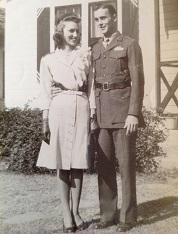 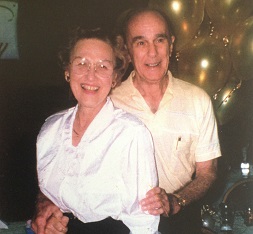 |
Bernard and Norma Palchak |
Son Bernard Palchak (1916-2002) was born on 20 June, 1916. He married Norma Irey (1921- ? ), daughter of Dorothy E. Irey. They met in 1942 at a USO dance in Jacksonville, FL. Norma volunteered to socialize and dance with the soldiers. When Bernard asked her to dance, it was love at first sight. She feigned thirst and maneuvered them off the dance floor, knowing that another soldier could tap in to cut in at any time. Once they left the dance floor, they never returned and talked all evening. That night, when Bernie went home, he called his mother and told her had met the women he was going to marry. Once they married they were rarely separated. Their children were Donald Palchak, Mary Watson, Nancy French and Susan B. Palchak. Bernard served with the U.S. Marine Corps during World War II and employed over the years as a supervisor for the Social Security Administration. By 1968, they spent part of their time in West Palm Beach, FL, and in 1982 relocated to Central Florida. They were members of St. Peter's Catholic Church. Bernard passed away in DeLand, Volusia County, FL on 23 Feb., 2002. Interment was in Oakdale Cemetery in DeLand.
|
St. Thomas Church, Braddock |
Daughter Irene Victoria Palchak (1918-1968) was born on 18 July, 1918 in Braddock. In 1946, she earned income as a clerk and lived with her widowed mother at 107 Nineth Street in Braddock. On 26 Nov., 1946, at the age of 28, she received a license to marry 47-year-old Ermine Louis Verna (1899- ? ), son of Italian immigrants Domenico and Filomena (Pecor) Verna and who the time worked as a moulder and resided at 585 Mifflin Road in Pittsburgh. But the marriage did not take place, and the license was cancelled. Four years later, now age 31, Irene did indeed marry but to 48-year-old widower Charles S. Stypulkowski (2 May 1902- ? ), son of Polish immigrants Charles and Sophia (Naroski) Stypulkowski. The wedding was held on 5 Aug., 1950, in the rectory of St. Thomas Church in Braddock, with Rev. F.R. Shields officiating. At that time, Irene was employed as an assembler in Braddock and Charles as a foreman, and his address was 6408 Marchand Street in Pittsburgh's East End. Irene married again by 1955 to John J. Zilko ( ? - ? ) and had these children -- Joan Hawkins and Steven Zilko. In 1955, she resided with her mother, the year the mother died. Her address in 1968 was 201 Hawkins Avenue. Sadly, Irene died on 4 Aug., 1968 at the age of 50. A notice of her passing appeared in the Pittsburgh Press.
Son Albert G. Palchak (1921-1963) was born on 5 Nov., 1921 in Braddock. He married Elizabeth "Betty" Boone ( ? - ? ). They did not reproduce. During World War II, he served in the U.S. Armed Forces. After the war, he settled in West Mifflin, at 457 Livingston Road, with a Dravosburg mailing address. Albert worked as a machinist. Sadness enveloped the family on 18 Aug., 1963 when Albert was fatally injured in an automobile accident in Homestead. With shock and bleeding due to a crushed chest and internal injuries, he was rushed to the Homestead Hospital, where he was pronounced dead on arrival. Following a requiem high mass celebrated in St. Barnabas Roman Catholic Church, burial was in All Saints Cemetery, and a death notice printed in the Pittsburgh Press.
Daughter Louise Palchak ( ? - ? ) married (?) Herbert. Their home in 1968 was in Midwest City, OK and in 2002 in Kingwood, TX.
Cousin Rosa Elizabeth (Straka) Tulencik
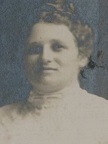 |
Rosa Tulencik |
Rosa Straka (1883-1956) was born in 1883 in Europe and accompanied her parents to America as a young girl.
On 29 May, 1905, at New Cumberland, WV, she married Michael Tulencik Sr. (1885-1945), son of Michael and Susan (Batcho) Tulencik. She was age 21 or 22 at the time, and he 20.
They lived in Toronto and had eight known children, Michael Francis "Mickey" Tulencik, Theresa Tulencik, Ferdinand "Fritz" Tulencik, Wendel Tulencik, Eleanor Tulencik, Thomas Tulencik, Elizabeth Tulencik and Anna Tulencik. Their home was at 721 North Fourth Street in Toronto.
Born in East Liverpool, the son of Michael and Susan Tulencik, Michael Sr. moved to Toronto at the age of five. He spent a quarter of a century there as a business owner, manufacturing soft drinks with the company Quality Soda Works. He was a member of the St. Joseph Greek Catholic Church, and belonged to its Jednota order.
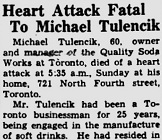 |
Steubenville Herald Star |
Michael Sr. was stricken with a heart attack and died on 9 Dec., 1945, at age 60, with burial in Toronto's Union Cemetery. His obituary was published in the next day's edition of the Herald-Star. Listed among the survivors were two grandchildren as well as his sister Mrs. John Brem of Toronto and brothers Joseph Tulencik and George Tulencik, also of Toronto. Rev. J.C. Muraida conducted the funeral service.
Rosa survived her husband by about 11 years. She passed into eternity in 1956 at the age of 73. Burial was in Union Cemetery.
Son Michael Francis "Mickey" Tulencik (1906-1994) was born on 31 July, 1906. He was married to Catherine Lillian Wilson (1914-2012), a native of Chicago and the daughter of William and Elizabeth (Young) Wilson. They did not reproduce. During World War II, Michael servied as a corporal in the U.S. Army. Catherine was employed for many years in the accounting department of General Motors' Pontiac Division. Michael died two days after Christmas 1994. Catherine survived him by 18 years and spent her final years in Port Orange, Volusia County, FL. There, she joined the Epiphany Catholic Church and belonged to the Wilbur by the Sea Association. On 21 Oct., 2012, at the age of 98, while a resident of Emeritus at Port Orange Assisted Living, she joined her husband in death. Her remains were returned to Toronto, with Rev. Fr. Thomas Vennetti officiating at the funeral service. An obituary was published in the Weirton (WV) Daily Times. They rest in Toronto Union Cemetery.
Daughter Theresa Tulencik ( ? - ? ) was deceased by 1993.
Son Ferdinand B. "Fritz" Tulencik Sr. (1910-1983) was born on 7 Jan., 1910. He was joined in wedlock with Mary M. (Aug. 6, 1914-1993). The couple produced two known children -- Ferdinand B. Tulencik Jr. and Rosemary Tulencik. In 1971, their residence was in Irondale, OH. Ferdinand Sr. died on Valentine's Day 1983 at the age of 73. Mary lived for another decade and passed into eternity at the age of 78 on 20 Feb., 1993. They are interred in Toronto Union Cemetery.
Son Wendel T. Tulencik (1912-1993) was born on 2 Jan., 1912 in or around Toronto. He was united in matrimony with Pauline Andrews (March 14, 1916-2004), a native of Toronto and the daughter of Joseph and Mary (Herrick) Andrews. The couple did not reproduce. For many years, Wendel taught in the Toronto School Systems, and for 14 years Pauline was a substitute teacher. They belonged to the St. Joseph Roman Catholic Church. Wendel succumbed at the age of 81 on 1 Nov., 1993. Now widowed, Pauline outlived her spouse by a baker's dozen of years. She passed away in Trinity Medical Center West at the age of 89 on 14 Nov., 2005. An obituary was printed in the East Liverpool Review. They are in eternal repose in Toronto Union Cemetery.
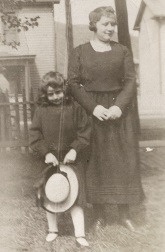 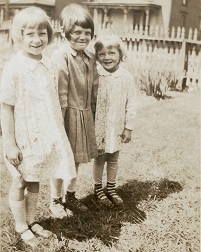 |
Left: Eleanor Tulencik (left) with cousin Lena (Straka) Perun. Right: Ann Tulencik (center) with cousins Bernadette Perun and Theresa Conlon. |
Daughter Eleanor Tulencik ( ? - ? ) married (?) Kondik ( ? - ? ).
Son Thomas Tulencik ( ? - ? ) was deceased by 1993.
Daughter Elizabeth Tulencik ( ? - ? ) married (?) LaVire ( ? - ? ).
Daughter Anna Tulencik ( ? - ? ) was joined in holy wedlock with Paul Unger.
Some of their offspring reside today in Toronto and some in Daytona Beach, FL.
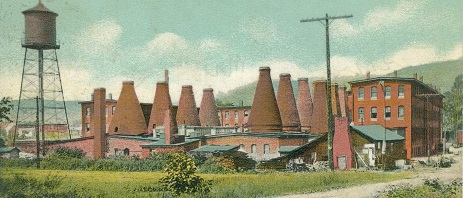 |
American China Company in Toronto, a local landmark |
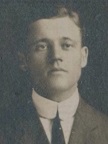 |
Wenzel R. Straka |
Cousin Wenzel Robert "Wence" Straka
Wenzel Robert "Wence" Straka (1887-1928) was born on 8 Dec., 1887 in the old country and came to the United States as an infant.
He was a partner in the family-owned laundry and celebrity sportsman until his untimely death at a young age. He was short and stout, with grey eyes and brown hair.
Wenzel has gone down in local Toronto lore as a "father of baseball in Toronto." He pitched for the Toronto Athletic Club teams, with Clemmy Stull as his catcher, on a team managed by William Burke. He was of short stature, and in a team photo taken in 1910 stands at far right, the shortest player on the squad. He is pictured in the 1969 book The Era of Elegance, held in the collection of the Steubenville Public Library.
 |
Wenzel R. Straka |
He married Anna McCart (1890-1980) in 1919 and they lived at 726 Daniel Street. Their three sons were John "Jack" Straka, Edward Straka and William "Bill" Straka.
Wenzel was required to register for the United States military draft in June 1917 as America's entry into World War I loomed closer. On his registration card, he wrote that he resided on North Fourth Street in Toronto and worked as a grocery clerk and meat cutter.
The Strakas provided room and board for Helen Leonard, who, in February 1926, married Peter Bloschak of Empire, OH in a ceremony held at St. Francis Church. Rev. Fr. Charles L. Walsh officiated at the celebration. A story about the wedding in the East Liverpool Evening Review reported that "The bride wore a gown of white satin and carried a bouquet of pink roses and valley lilies. Her bridesmaid was Miss Mary Straka, who was dressed in white crepe. Immediately after the ceremony a wedding breakfast was served at the groom's home in Empire."
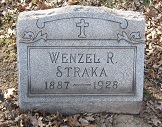 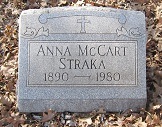 |
| Union Cemetery |
During the Christmas season of 1928, Wenzel contracted a serious case of myocarditis and pneumonia. After suffering for four days, the 41-year-old succumbed on 21 Dec., 1928, in the city hospital in East Liverpool, Columbiana County, OH. The next day's edition of the Herald-Star ran a page-wide headline, "Prominent Toronto Man First Victim of Influenza." Said the Herald-Star, "The death of Mr. Straka was a complete shock to his local friend as he was a highly respected and well-liked citizen. His family has the sincere sympathy of the entire community in this sudden death at this holiday season..... The American Legion has charge of the services at the grave as well as some members of the Legion being in constant attendance while the body lay in state."
The funeral service was held at the St. Francis Church, officiated by Father Charles L. Walsh. He rests for eternity beside his mother in the Union Cemetery in Toronto.
Anna outlived her husband by an astounding 52 years. She passed away in 1980, at the age of 90, and is buried next to her husband.
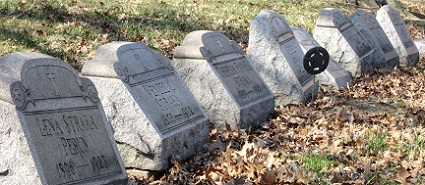 |
Row of Straka graves at Toronto's Union Cemetery |
Son John "Jack" Straka (1922-1985) made his residence in Toronto. He died in 1985.
Son Edward "Ed" Straka married Olga Chadwick. They had four children -- Michael Straka, Mark Straka, Mary Ellen Brown and Milissa Straka. Edward passed away in 1987. As a widow, Olga made her residence in Norwalk, OH. Sadly, their son Michael (1950-1993), who worked in the special education department of the Kalamazoo Central and Loy Norris High Schools in Michigan, died at the age of 43 in 1993.
Son William "Bill" Straka (1924-1994) was born on 4 April, 1924. He apparently did not marry, nor did he reproduce. During World War II, he served in the U.S. Army, and after the war was a member of the Toronto American Legion and Veterans of Foreign Wars posts. He also belonged to St. Francis Roman Catholic Church. During his working career, William was an office manager for Songer Construction Company in Buffalo, NY. After retiring, he returned to Toronto and lived in a home on Main Street. William died at the age of 70 on 20 Aug., 1994. His funeral mass was overseen by Monsignor Roger Foys, followed by interment in Toronto Union Cemetery. His obituary in the Herald-Star said that he was survived by nephew Mark Straka of Norwalk, OH, and by nieces Mary Ellen Brown of Norwalk and Milissa Straka of Shelby Township, MI.
The Strakas have an interesting sports connection to a Baseball Hall of Famer. One of the family played football at Steubenville Big Red High School in the 1930s with George Michael Fingers. Some of the other players on the squad were DiCarlo, Stojak, Fletcher and Hampton. Fingers also pitched and signed a minor league contract with the St. Louis Cardinals, allegedly rooming with Stan Musial in the Southern League. But he never made it to "The Show," and returned to Toronto. George married and had a family, working in local steel mills and pitching in Ohio Valley leagues. He spent quite a bit of time playing catch with his young son Roland and coaching him on the finer points of pitching. Eventually George and the family moved to California circa 1956, giving the son year-round opportunities to fine-tune his game. The son eventually reached the Major Leagues and pitched for the Oakland A's, San Diego Padres and Milwaukee Brewers, sporting a signature handlbar mustache and making his mark as a relief specialist, logging 341 saves. The son also captured both a Cy Young and American League MVP Award. In 1992, the son was inducted into the Hall of Fame -- known widely to all baseball fans everywhere as "Rollie" Fingers.
|
Toronto's North Third Street, early 1900s |
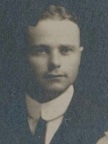 |
Thomas W. Straka |
Cousin Thomas Wenzel Straka
Thomas Wenzel Straka (1889-1975) was born in Pittsburgh on Christmas Eve 1883, the first of the family to be born in America.
He was short and stout, with grey eyes and brown hair.
At the age of three, he migrated with his parents and older siblings to Toronto. He was a gradute of Toronto High School and obtained further education at the Steubenville Business College. Upon graduation, he joined his father in the operation of the family grocery in the north end of Toronto and also earned income by farming for his father.
When the United States prepared to enter World War I, in June 1917, Thomas was required to register for the military draft. In the documents, he disclosed that his father Wenzel Straka Sr. was a farmer in Knox Township. His address at the time was North Fourth Street in Toronto. Thomas later joined the American Expeditionary Force, served as a musician in the 332nd Regimental Band, and saw active service in France and Italy.
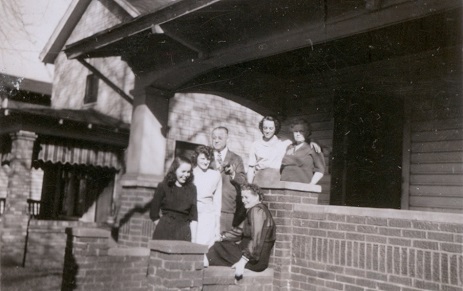 |
Standing, L-R: Mary Frances Armstrong, Jane Hudock, Thomas Straka, Margaret Palchak, unknown. Seated: Irene Conroy. |
Upon discharge from the army, he returned to Toronto and in 1920 married Nan Bell (1887-1945), daughter of Irish immigrants David and Elizabeth (Rainey) Bell. They produced four children -- Thomas P. Straka, Nancy Hook, Mary Frances Armstrong and Jane Hudok -- and resided at 625 North Fourth Street in Toronto.
Thomas in 1919 helped to found the Home Laundry and Dry Cleaning Company in Toronto with his brother Wenzel. Their brother Albert joined the firm three years later, in 1922. According to the 1929 publication, Industrial History of Toronto, the laundry was first housed in the Henderson building on Third Street. In 1921 it was relocated to the brick Edwards building, formerly a blacksmith shop, and directly behind the theatre.
| The laundry at this time [1921] employed four girls and had but one delivery horse and wagon. In 1923 a modern fire proof dry cleaning department was added and in 1927 a second story was added to the main building. At the time of the third enlargement, new and modern laundry and dry cleaning equipment was purchased and installed. There are now twenty-eight girls and six men employed by this progressive institution and they are operating daily, seven auto trucks. From a meager start, this enterprising firm has developed steadily and substantially until the present time when they are equipped to do a quantity and quality of work that is second to none in the valley. |
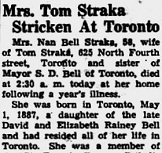 |
Steubenville Herald Star |
Thomas was a founding member of the St. Mihiel Post of the American Legion and circa 1929 served as its commander. He also was a member of the Knights of Columbus and the Kiwanis Club of Toronto. Tragedy struck in 1928, when Thomas' brother and business partner Wenzel died during an epidemic of influenza. Thomas then became president and general manager, and his brother Albert was plant manager.
Adding to their influence was the fact that Nan's brother, S.D. Bell, served as Mayor of Toronto in the mid-1940s. Nan herself was a member of St. Francis Roman Catholic Church and the Auxiliary of the American Legion.
During World War II, their son Thomas served as a staff sergeant in the U.S. Army.
After enduring heart disease and hypertension for two years, Nan passed away on 3 Dec., 1945. Her obituary in the Steubenville Herald-Star said she was "active in civic affairs of the city and had a large circle of friends who will regret her death."
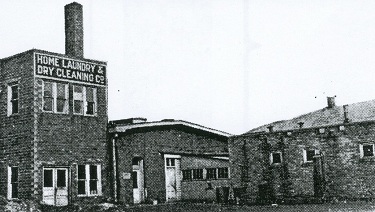 |
| The Strakas' Home Laundry & Dry Cleaning Co., published in Industrial History of Toronto, 1929 |
 |
Steubenville Herald Star |
Thomas lived for another three decades and made his home in the Michael Myers Apartments. After the laundry closed, he worked as a bookkeeper for the Civil Service.
He died on or about 19 Dec., 1975, with his obituary published in the Herald-Star. They are buried together in Union Cemetery in Toronto. At the time of his death, he was survived by 14 grandchildren and six great-grandchildren.
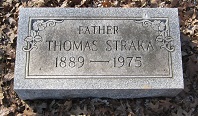 |
Union Cemetery |
Son Thomas P. Straka (1924-1989) resided circa 1975 in Poughkeepsie, NY. He died on 10 April, 1989, in Lake Odessa, Ionia County, MI. His remains were returned to Toronto for burial beside his parents.
Daughter Nancy Straka was united in matrimony with Joseph Hook. They bore several sons, among them Robert A. Hook and Joseph "Pokey" Hook.
Daughter Mary Frances Straka wed Maurice Armstrong. They lived in Lake Odessa, MI.
Daughter Jane Straka (1930-2014) was born on 27 Feb., 1930 in Steubenville. When she was 18 years of age, on 27 Nov., 1948, she married Paul Hudok (June 21, 1927-1982). The ceremony was held in St. Francis Church in Toronto. They produced several children -- Christopher J. Hudok, Kenneth Huok, Judy Richards, Paulette Petrisko, Becky Beswick and Betty Walker. The Hudoks belonged to Toronto's St. Joseph Catholic Church, where Jane was a member of the Catholic Women's Club and was employed as a housekeeper at the church rectory. Sadly, Paul died on Aug. 28, 1982 at the age of 55, ending their marriage of 34 years. Jane survived her husband by a remarkable 32 years. During that time, she endured the death of her son Christopher but relished having many of her adult children near her in Toronto. As a patient in Trinity Medical Center West in Steubenville, Jane died four days after Christmas 2014, with burial in Union Cemetery. Father Thomas Vennitti led her mass of Christian burial at the family church, with interment following at Union Cemetery.
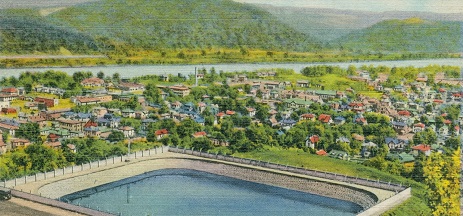 |
| Bird's eye view of Toronto, Ohio, from the Nob |
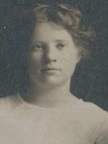 |
Anna Straka |
Cousin Anna I. Straka
Anna I. Straka (1892-1971) was born on 18 May, 1892 in Pennsylvania., probably in Braddock.
She never married but spent her life in Toronto, making a home with her sister Amelia. She was a member of St. Joseph Roman Catholic Church and belonged to its Catholic Women's Club.
When Anna's sister Lena Perun died in 1923, leaving behind an infant baby Bernadette, Anna and Amelia took the girl into their home. They are shown together in the 1940 U.S. Census.
Circa 1937, she made her home at 716 North Fourth Street in Toronto. That year, she was the informant for the death certificate of her sister Margaret Conlon.
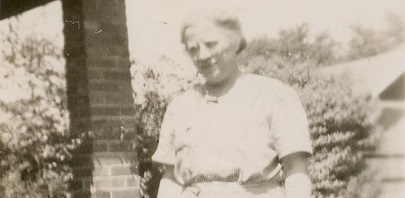 |
| Annie at home on Fourth Street, Toronto |
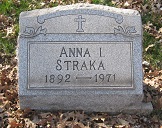 |
Union Cemetery |
In the early 1970s, she had moved into the residence of her married niece Bernadette Kondik in Toronto at 714 North Third Street.
She was admitted to St. John's Hospital in Steubenville, where she died on 21 Feb., 1971, at the age of 79. Following a requiem high mass, celebrated by Fr. John Kolesar of her church, her remains were interred in Toronto's Union Cemetery. An obituary was printed in the East Liverpool Evening Review.
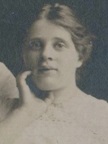 |
Amelia Straka |
Cousin Amelia C. "Millie" Straka
Amelia C. "Millie" Straka (1894-1971) was born on the Fourth of July 1894 in Toronto, Jefferson County.
As with her sister Anna, she never married but spent her entire life in the Toronto area. Both were members of the St. Joseph Catholic Church.
Amelia was a talented organist who played in and around Toronto, including at many weddings over the years in St. Joseph Roman Catholic church. As reported in the gossip columns of the East Liverpool Evening Review circa 1928, she also enjoyed visiting relatives in Braddock, near Pittsburgh, believed to have been her elder sister Mary Palchak.
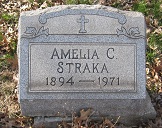 |
Union Cemetery |
Toward the end of her life, she and her unmarried sister Anna made their home with a niece and husband, Bernadette and Frank Kondik in Toronto.
She entered the Forester Nursing Home in Wintersville, OH, where she died on 3 March, 1971, at the age of 77, a month after the passing of her sister Anna. A requiem high mass was held at the family church, led by Rt. Rev. Msgr. Andrew R. Beros. The Evening Review printed an obituary. The sisters rest together in the family plot at Union Cemetery.
Cousin Pauline Cecelia "Lena" (Straka) Perun
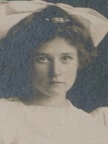 |
Lena Perun |
Pauline Cecelia "Lena" Straka (1897-1923) was born in April 1897 in Toronto.
On 6 Aug., 1921, when she was 24 years of age, Lena married 23-year-old Frank Perun (1898-1967?), son of Joseph and Mary Perun. The nuptials were performed by Rev. Charles L. Walik, a Catholic priest in Toronto.
They made their home in Toronto, where Frank held employment as a clay worker. During their brief married lives together, they produced a daughter, Bernadette C. Perun.
Sadly, suffering from pneumonia at the age of 26, Lena succumbed just two months after giving birth to their only child, on 16 May, 1923. She rests beside in the Straka family plot in Toronto's Union Cemetery.
Frank did not remain in Toronto, and his infant daughter was taken in by Lena's sister to raise. He is believed to have spent the final years of his life in Cleveland, Cuyahoga County, OH, as he apparently died there in June 1967.
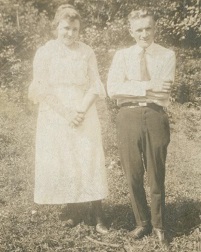 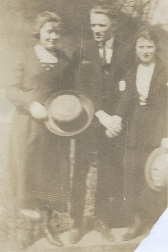 |
| Lena and Frank -- with her sister Margaret Conlon at right |
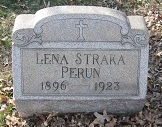 |
Union Cemetery |
Daughter Bernadette Perun (1923-living) was born on 9 April, 1923 in Toronto. She was only two months of age when her mother died. Bernadette became a registered nurse and resided in Toronto, When she was 23 years of age, on 26 Oct., 1946, she was united in holy wedlock with Frank J. Kondik (1923-2007), a native of Raccoon, PA and the son of John and Mary (Irohshak) Kondik Sr. Rev. Andrew R. Beros performed the ceremony in Toronto at St. Joseph Roman Catholic Church. At the time, Frank lived in Weirton, WV and was a mill worker there. The Kondiks produced two offspring, Kathleen Lowe and Francis Kondik. They initially lived under the roof of Bernadette's unmarried aunts Anna and Amelia Straka. Later, circa 1971, they repaid the favor by providing a home for the aunts. Frank served in the U.S. Army during World War II with the 173rd Field Artillery. In the postwar years, Frank was employed by Weirton Lumber Company. Upon his retirement, he worked as a security guard for Hancock Manufacturing in Toronto and as a building inspector for the town. They belonged to the St. Joseph congregation and its Holy Name Society, the Knights of Columbus, the Toronto post of the American Legion and a charter member of the local Dyer Country Club. When her adult son would return home from Texas for visits, she would prepare his favorite ethnic meal of city chicken and cabbage rolls. Frank passed away at the age of 84 on 12 Nov., 2007 in Valley Hospice Care Center North in Steubenville, Jefferson County, OH. After a funeral mass at the family church, and additional military honors provided by his Legion colleagues, his remains were lowered into repose at Union Cemetery.
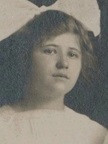 |
Irene Conroy |
Cousin Irene A. (Straka) Conroy
Irene A. Straka (1898-1971) was born on 29 Oct., 1898 in Toronto, Jefferson County.
On 20 Oct., 1920, at the age of about 22, she married 25-year-old Harry Anthony Conroy (11 Oct., 1895-1961), a native of Marion, Indiana and the son of Harry S. and Elizabeth M. (Deechan) Conroy. The ceremony was held in Toronto, officiated by Rev. Fr. Arthur Fuller. At the time of their wedlock, Harry was a pipe inspector living in Steubenville.
They relocated to Kalamazoo, Michigan in 1928 and were in Grand Rapids, Michigan in 1930.
Their four known sons were Harry W. Conroy, Robert E. "Bob" Conroy, John V. Conroy and William L. "Bill" Conroy, the first two born in Ohio and the younger two in Michigan.
Harry was employed as a commercial salesman of laundry supplies in Grand Rapids circa 1930. He remained in this occupation for years and by 1940 they had moved back to Kalamazoo, as shown by the U.S. Census.
Harry passed away in April 1961. His remains were placed into eternal repose in Mount Olivet Cemetery in Eastwood, Kalamazoo County.
Irene survived her husband by a decade. In early 1971, Irene was back in Kalamazoo and named in the East Liverpool Evening Review obituary of her sister Anna. Sadly, though, she died in April 1971.
Son Harry W. Conroy (1922- ? ) was born in about 1922 in Toronto.
Son Robert E. "Bob" Conroy (1925- ? ) was born in about 1925 in Toronto.
Son John V. Conroy (1927- ? ) was born in about 1927 in Grand Rapids.
Son William L. "Bill" Conroy (1930- ? ) was born in about 1930 in Grand Rapids.
Their offspring today dwell in Michigan.
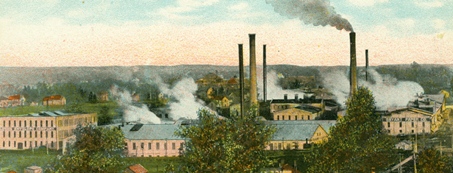 |
| Industrial Kalamazoo, Michigan |
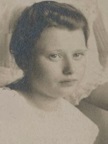 |
Margaret Conlon |
Cousin Margaret Mary (Straka) Conlon
Margaret Mary Straka (1900-1937) was born on 27 Oct., 1900 in Toronto.
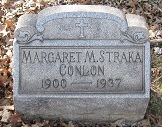 |
Union Cemetery |
At the age of 24, on on Jan. 27, 1925, she married 23-year-old John J. Conlon (1901-1952) , son of James and Bridget (Kelly) Conlon. She was a year older than her husband.
They produced four known children, Theresa Dougherty, James Joseph Conlon, Francis Conlon and Robert J. "Bob" Conlon.
The Conlons resided at 901 Main Street in Toronto. John was employed circa 1930 as a washer operator at the Straka family laundry. They were members of the St. Francis Roman Catholic Church, where Margaret belonged to its Altar Society.
Sadly, Margaret suffered from breast cancer. Just four weeks after diagnosis, and just a dozen days before her 36th birthday, she passed away at Ohio Valley Hospital in Steubenville, Jefferson County, on 15 Oct., 1937. Interment was in Toronto's Union Cemetery.
John survived another 15 years, an in 1940 had moved the children into the home of his parents in Toronto. When the 1940 federal census enumeration was made, he worked for the Works Progress Administration, known as the WPA. During the 1930s, with the nation in the iron grip of the Great Depression, obtaining employment was exceptionally difficult for laborers. One of the ways President Roosevelt and the federal government tried to overcome this was by forming the WPA. Over the years, the WPA workers built public works projects, such as roads, bridges, retaining walls and buildings. Many of these structures still exist today and continue to benefit society. The WPA is widely considered one of the Roosevelt's largest and most ambitious undertakings of his "New Deal" to get the nation back on sound economic footing.
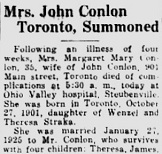 |
Steubenville Herald Star |
Later, John made his home at 706 North Fourth Street. He worried as his son James served during World War II in the occupation of Japan, and as son Robert joined the military during the Korean War.
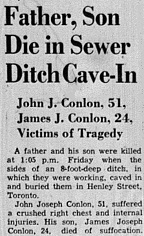 |
Steubenville Herald Star |
In 1952, John and his unmarried son James worked together as construction laborers for Hilz Construction of Toronto, which at the time was building homes in town.
Tragedy rocked the family on 14 March, 1952, while John (age 51) and son James (age 24) were at work inside a sewer ditch eight feet deep on Henley Street. The walls of the hole suddenly collapsed, along a length of 30 feet, burying them under tons of earth. The father was crushed to death, while the son's head was above ground. Reported the Herald-Star, "Workers near the spot rushed to the rescue and dug frantically, clearing his head from the dirt. The pressure of the rock and dirt on the young man's chest apparently caused suffociation.... It took more than an hour for police, firemen and volunteer workers to remove the bodies from the hole."
Father and son are buried on either side of Margaret at Union Cemetery.
Daughter Theresa R. Conlon (1926- ? ) was born on 16 Dec., 1926. As a young unmarried woman, she earned a living working as a clerk in or around Toronto. On June 24, 1946, at the age of 19, she was wedded to 24-year-old Joseph L. Dougherty (13 May, 1922- ? ), son of Richard and Margaret (Green) Dougherty. Rev. Raymond Harris, of St. Francis Catholic Church, officiated at the wedding. Their home circa 1952 was in Toronto.
Son James Joseph Conlon (1928-1952) was born in about 1928.
Son Robert J. "Bob" Conlon (1929-1978) was born in about 1929. He served in the U.S. Army during the Korean War. He was stationed at Fort Campbell, KY and held the rank of corporal. At the age of 23, on 5 June, 1953, he was joined in matrimony with 22-year-old Nadean Godish ( ? - ? ) of Steubenville and the daughter of Mike and Mary (Ogrizovish) Godish. Robert worked as an apprentice carpenter at the time of marriage, and Nadean as an IBM computer operator. He died in 1978, at the age of 49. He rests beside his parents in Union Cemetery.
Son Francis Conlon ( ? - ? ) was born in (?).
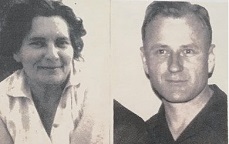 |
Margaret and Albert Straka |
Cousin Albert A. Straka Sr.
Albert A. Straka Sr. (1903-1951) was born on 22 Feb., 1903 in Toronto.
On 1 July, 1924, when he was age 21 and she 20, he wedded Margaret Kilmartin (1904-1964). They had known each other for a lifetime, having attended first grade together at St. Francis Catholic School in Toronto and continuing over the years.
They produced eight children -- Albert Straka Jr., Charles "Chape" Straka, James Patrick Straka, Bernard Straka, Paul Straka, William R. "Bucky" Straka, Richard "Dick" Straka and Mary Theresa Robinson.
The Strakas lived at 703 Market Street in Toronto.
In about 1921, when he was age 18, Albert joined his older brothers Wentzel and Thomas in the family's dry cleaning business in Toronto. Eventually he became owner of the firm and spent a total of three decades in the laundry business. He was a member of the St. Francis Roman Catholic Church, and was active in its Holy Name Society. He also was a regular participant in the Toronto Bowling League.
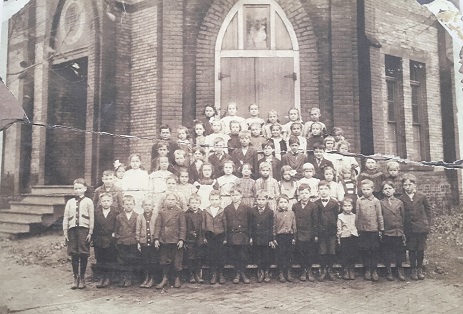 |
| St. Francis School, 1912. Albert A. Straka Sr. stands 6th from left, front row. His future wife Margaret Kilmartin is 4th from left, 2nd row. |
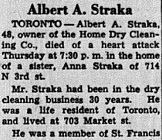 |
Steubenville Herald Star |
He died of coronary thrombosis (heart attack) at age 48 on 3 May, 1951, while at the home of his sister Anna in Toronto. He was laid to rest in the Toronto Union Cemetery.
Son Albert Straka Jr. (1924-1977) was born on 15 Dec., 1924 in Toronto. He served in the U.S. Navy during World War II, with service on the USS Essex and in the Philippine Islands. After the war, he returned to Toronto where he apparently remained for the balance of his life. In 1948, in nuptials held at St. Agnes Catholic Church, Albert was joined in wedlock with Irma Fracasso (1926-living). Their four children were Valerie Barth, Karen Straka, Fred Straka and Brian Straka. In the 1970s, their address was 702 Jefferson Street in Toronto. Albert continued to operate the family's Home Cleaner Company for three decades. With the advent of wash-and-wear and permanent press clothing, the public no longer needed dry cleaning, and the business closed in 1971 after a run of 52 years. Active in the communty, he was a member of the St. Francis Roman Catholic Church, the American Legion Post 86 and the Dyer Country Club. He served as president of the local Lions Club, was a grand knight of the Knights of Columbus and an offer in the Touchdown Club. Albert died at the age of 52 on 17 Nov., 1977 while a patient at Ohio Valley Hospital in Steubenville. Burial was in Union Cemetery following a funeral mass at St. Francis Church led by Msgr. Angelo Cappelli and burial in Union Cemeter. An obituary in the East Liverpool Evening Review noted that he was survived by a sister and six brothers.
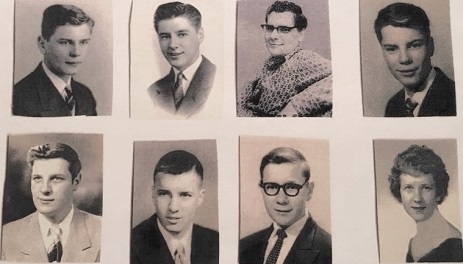 |
The Straka offspring, in birth order -- Albert Jr., Chape, James, Bernard, Paul, Bucky, Dick and Mary Theresa |
Son Charles "Chape" Straka Sr. (1927-1989) was born in 1927. He wedded Wanda Needham ( ? -1958). They made their home in Steubenville, OH and bore four children -- Charles Straka Jr., Pamela Zarych, Faith Joynson and Margy Avila. Chape served in the U.S. Navy during World War II. He ran a branch of the family dry cleaning business in Steubenville. Sadly, Wanda passed away at an untimely age in 1958. Chape outlived her by more than three decades and married again to Alicia Achammer ( ? - ? ). The second marriage produced two children -- Lisa Straka and Christy Straka. Chape died in 1989 with burial in the large family plot of graves at Union Cemetery.
Son James Patrick ("Jim" or "Pat") Straka (1929-1994) was born on 3 Sept., 1929 in Toronto. He was a member of the St. Francis Roman Catholic Church, and was a longtime maintenance and repair department employee for the city of Toronto. In retirement, he lived with his sister Mary Theresa Robinson on East Terrace Drive in nearby Wellsville. James died in Ohio Valley Hospital in 1994 at the age of 64, with burial in Toronto's Union Cemetery.
Son Bernard John Straka (1931-1984) was born on 3 Feb., 1931. During the Korean War, he served in the U.S. Navy. Later, Bernard lived and worked for United Airlines in Florida before relocating to Southern California. In 1977, his home was in Los Angeles. He was united in marriage with Gayle Bowman ( ? - ? ). The couple did not reproduce. He died on 9 Jan., 1984, and his remains were shipped back to Toronto for funeral services in St. Francis Church followed by burial in Union Cemetery.
Son Paul E. Straka (1932-2009) was born the day after Christmas 1932. In 1962, when he was about 30 years of age, he was joined in wedlock with Dolores (8 April, 1928-2012). They resided in Toronto and had an only daughter, Susan Marie. As did his brother Bernard, Paul was a U.S. Navy veteran of the Korean War. He was employed for many years with the Ohio Edison power plant in Stratton, OH. In his free time, he was active with the St. Mihiel post of the American Legion in Toronto, including a term as commander from 1966 to 1969. He died on 25 Jan., 2009, with funeral services held in St. Francis Church and interment in Union Cemetery. Dolores survived another three years and succumbed on 30 Aug., 2012.
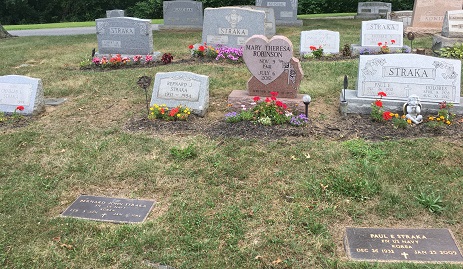 |
The Straka plot in Toronto's Union Cemetery |
Son William R. "Bucky" Straka (1934-living) was born in 1934. On 25 July, 1959, in nuptials held at Holy Name Cathedral in Steubenville, he married Mary Catherine Gmys (1940-living). He served his country in the Army during peacetime and was stationed in Korea and Japan in 1955-1958. The couple made their home in Toronto and are the parents of three children -- William Straka Jr., David Straka Sr. and Judith Gillis.William was employed at Titanium Metals in Toronto (AKA Timet) until his retirement in 1995. He served as an elected trustee of Island Creek Township for 24 years. In 1998, they relocated to Las Vegas, NV where they spent the next 16 years. In 2014, they returned to their hometown of Toronto and reside on Banfield Avenue. Mary Catherine initiated contact in July 2018 with the founder of this website and has shared her extensive knowledge of the family.
Son Richard V. "Dick" Straka (1938-2004) was born on 13 Nov., 1938. He never married. As a young man, he joined the U.S. Army and was stationed in West Germany during the "Cold War." He then eached a bachelor's degree in education at Kent State University while working as a display designer at The Hub department store in Steubenville. Over the years, he taught at the middle, junior high and high school levels in Barberton, OH. Later, in Akron, OH, he taught special-needs children, retiring in 1997. He died on 18 June, 2004 while living in the home of his sister Mary Theresa in Wellsville. Funeral services were held in St. Francis Church, and burial followed in Union Cemetery.
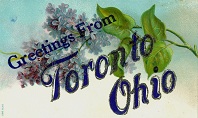 |
Daughter Mary Theresa Straka (1941-2012) was born in 1941, the youngest of eight children and the only daughter of the family, growing up with seven older brothers. She was joined in matrimony with iron worker Harold Robinson (1941-1995). The couple bore four daughters -- Janelle Koontz, Karen Brown, Carol Lynn Campion and Lori Robinsin. In 1977, their home was in Wellsville, OH. The couple eventually separated. Tragically, Harold fell from a building he was helping to construct and was in a vegetative state for two years until death in 1995. He rests at Sugar Grove Cemetery near Toronto. Mary Theresa lived for another 17 years. She died on 6 July, 2012, with burial in Union Cemetery after funeral services at St. Francis Church. Inscribed on her red granite grave marker, in the shape of a heart, are the words "Forever in our hearts."
In Closing
This page would not have been possible without the memories and encouragement of Andrew and Veronica's children and grandchildren over the years. Please email me with any comments or questions. I thank you all with much love and gratitude.
-- Authored by the Jagerskis' great grandson Mark A. Miner